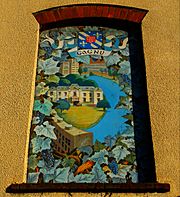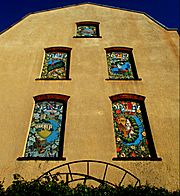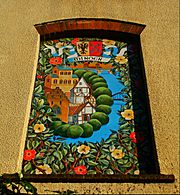Sutton twin towns mural facts for kids
Quick facts for kids Sutton twins towns mural |
|
|---|---|
 |
|
| Artist | Rob Turner and Gary Drostle |
| Year | 1993 |
| Medium | Plywood |
| Subject | Mural |
| Condition | Good |
| Location | Sutton |
| 51°21′37.5″N 0°11′29.6″W / 51.360417°N 0.191556°W | |
The Sutton Twin Towns Mural is a big artwork made of seven separate paintings. You can find it on Sutton High Street in Sutton, a town in Greater London, England. It's one of six public artworks located in the center of Sutton.
Contents
What is the Sutton Twin Towns Mural?
This amazing mural was created in 1993 by two artists, Gary Drostle and Rob Turner. They made it to celebrate 25 years of Sutton being "twinned" with Wilmersdorf in Berlin. Twinning means two towns or cities in different countries become partners to promote friendship and understanding.
The mural is located on the side of an old building at the end of Sutton High Street, close to the train station. The seven paintings are made on Plywood and are placed inside frames that look like windows.
Which Towns are Featured in the Mural?
The paintings show scenes from the London Borough of Sutton and its four European "twin towns":
- Gagny, a suburb of Paris in France.
- Gladsaxe, a suburb of Copenhagen in Denmark.
- Minden in North Rhine-Westphalia in Germany.
- Charlottenburg-Wilmersdorf in Berlin, Germany.
Sutton also has a "friendship link" with Tavernelle, which is in Italy.
The Sutton and Cheam Society praised the twin towns mural in 1994. The same artists, Drostle and Turner, also created the Sutton Heritage Mosaic.
What Can You See in the Mural?
Each of the five main paintings shows important places and symbols from its town. You can also see the town's heraldic shield (like a coat of arms) above the other pictures.
To show how much each town cares about the environment, each painting also includes a plant. For Sutton, there's a separate smaller painting above its main one. It shows a beech tree, which represents good fortune. The area of Carshalton Beeches in the borough gets its name from these trees.
How Were the Designs Created?
The artists worked with students from Sutton schools and local community groups. Each group focused on a different twin town to come up with ideas for the designs.
Here are some of the things you can spot in the paintings:
- Sutton's mural features famous landmarks like Whitehall in Cheam, Carshalton Ponds, Honeywood House, and the spire of Trinity Church in Sutton town center.
- Gagny's mural shows the Hôtel De Ville, which is an old manor house surrounded by a garden.
- Gladsaxe's mural displays Bagsværd Lake, Bagsværd Church, and Højgârd.
- Minden's mural includes its cathedral, the Westerorbrücke bridge, and the Mittelandkanal Aqueduct.
Learning More: The Information Board
In 2011, the Sutton Council decided to put up a new sign to explain the story of the murals. This sign was placed on the street, right in front of the mural, near the Cock and Bull pub.
Councillor Graham Tope explained why the new sign was important: "These murals are a key part of our borough's history. I think it's right that people can learn more about them. The borough's first European connections started in 1968. Twinning continues to be an important part of our borough's identity."
Sutton's Connections with its Twin Towns
The twinning program helps keep the towns connected. For example:
- In November 2015, the Mayor of Sutton sent messages of sympathy to Gagny, Paris, after the terrorist attacks there.
- In September 2016, a French folk dance group from Gagny, called L’Aubade de Quercy, visited Sutton. They performed with UK dance groups in Trinity Square.




